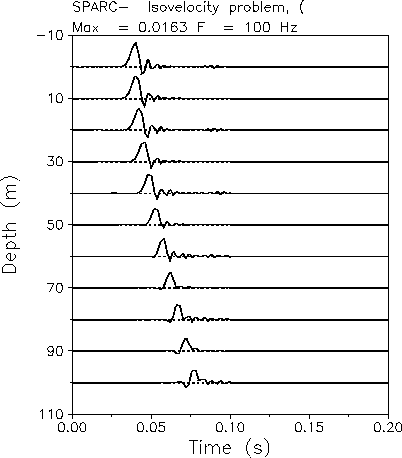
Figure: Sample output of PLOTTS: an isovelocity problem.
PLOTTS PLOTs the Time Series used in or created by a SPARC .
If there is a single receiver depth, the horizontal axis is time and the vertical axis is amplitude.
If there is more than one receiver depth the each receiver time series is shifted vertically in accordance with the receiver depth.
Files:
Name Unit Description
Input
*.PLP 1 PLot Parameters
*.?TS 10 Source/Receiver Time Series
Output
*.PRT 6 PRinT file
*.GRN 20 GReen's function
*.RTS 35 Receiver Time Series
---------------------------------------------------------
EXAMPLE AND DESCRIPTION OF PLP FILE:
5.0 0.0 5000.0 'PH+N' ! FREQ FMIN FMAX PULSE
0.0 1.5 0.5 / ! TMIN TMAX TINC (s) TAXL (cm)
-1.0 1.0 1.0 / ! YMIN YMAX YINC (m) YAXL (cm)
(1) - FREQUENCY SPECTRUM / PULSE INFORMATION:
Syntax:
FREQ FMIN FMAX PULSE
Description:
FREQ: Characteristic frequency (Hz).
This is only used for those canned signals
defined by a characteristic frequency.
FMIN: Low cut frequency (Hz)
FMAX: High cut frequency (Hz).
PULSE(1:1): Signal type
'P' Pseudo-Gaussian
'R' Ricker wavelet
'A' Approximate Ricker wavelet
'S' Single sine
'H' Hanning weighted four sine
'N' N-wave
'G' Gaussian
'F' From an '.STS' (Source Time Series) file.
'B' From an '.STS' file Backwards
PULSE(2:2): Hilbert transforming. This is used to eliminate
the left travelling wave.
'H' perform a Hilbert transform of the signal
'N' don't
PULSE(3:3): Signal sign flipping.
'+' don't flip it
'-' flip it
PULSE(4:4): signal filtering.
'L' low cut filter
'H' high cut filter
'B' both high and low cut filter
'N' no cut
(2) - TIME AXIS INFO
Syntax:
TMIN TMAX TINC TAXL
Description:
TMIN: First time (s ).
TMAX: Last time (s ).
TINC: Time interval for tick marks (s ).
TAXL: Time axis length (cm).
(3) - VERTICAL AXIS INFO
Syntax:
YMIN YMAX YINC YAXL
Description:
YMIN: Y minimum (m ).
YMAX: Y maximum (m ).
YINC: Y interval for tick marks (m ).
YAXL: Y axis length (cm).
If there is only one time series to plot
then YMIN, YMAX should normally be -1, 1.
If there are multiple time series corresponding
to different depths or ranges then YMIN, YMAX
should normally be the max and min depths or ranges.

Figure: Sample output of PLOTTS: an isovelocity problem.